AI 4 finance: 4 questions; 4 practical applications; 4 critical conclusions
We know it can be scary – the idea that your job (and your hard-earned expertise) may be quickly replaced by technology. Equally as scary? Falling behind – the idea that the adoption of Artificial Intelligence (AI) within the finance function happens so rapidly that you are now behind learning curve.
For most, the former is more an unwarranted worry. AI promises to supplement, not replace finance expertise. But, the latter is, in fact, of sound concern. Relative to other technologies, AI’s embrace has happened in an accelerated fashion even in industries that have long been tech-averse.
And finance, in particular, is primed for even more accelerated adoption. Why? Data. The office of the CFO is the owner of all company information (of course financial metrics but increasingly operational data as well). Because finance has large stores of data under its control, AI can provide the function with a quicker and more comprehensive view of critical inputs and outputs.
It sounds promising, but we know it also may seem intimidating – perhaps prohibitively so. We’re here to help – by asking (and answering) the 4 questions internal finance professionals need to know at the start of their AI journey. And, to help make the subject even less intimidating, we’ve started with the most basic questions (the ones you may have been too embarrassed to ask):
QUESTION 1: What is AI?
AI is an area of computer science focused on the creation of intelligent algorithms that work and perform tasks like humans. These tools are able to teach themselves, organize and interpret information to make predictions based on this information. AI tools can expedite routine tasks like data analysis and report creation, leaving finance professionals free to focus on more strategic, value-adding activities.
QUESTION 2: What are Generative AI technologies like ChatGPT?
Generative AI refers to deep-learning AI models that can generate high-quality text, images, and other content based on the data for which they were asked. ChatGPT is one such popular generative AI tool or Large Language Model (LLM). Now, there are many different LLMs (like Google’s Bard, and DallE), and there will certainly be more in the future from other major technology players (Meta, for one).
QUESTION 3: Why is finance ripe for AI?
In a word: data. Data is critical to run the business – but there is such a thing as too much data. In 2010, we collectively created a trillion gigabytes of new data. By 2025, that number is expected to soar past 175 zettabytes of new data generated annually. When that much data needs to be crunched manually, finance professionals face a reality of diminishing returns: with so much information available, it becomes increasingly difficult for humans to work with it effectively. When manually sorting data, finance professionals can’t be expected to spot all the trends or opportunities, see mistakes and gaps, or notice the anomalies and inconsistencies across millions of individual data points. And, because finance is pressured to do more, faster, professionals often run on faith that errors or gaps will either be too small to matter or large enough to be noticed eventually.
AI solves for that: It can aggregate, categorize and summarize infinite zettabytes of data to make it manageable, and then analyze for the data trends from there, finding all the otherwise impossible to find gaps, errors, and inconsistencies.
QUESTION 4: That’s great in theory, but what are the practical applications of AI in the finance function?
There are many, but here we are outlining 4 critical areas in which AI can help optimize the work of the finance function immediately:
- Application 1: Less digging; more informed asking
One of the more important roles of the finance function is to draw conclusions and produce insights about the business based on financial results. Traditionally, this exercise would require a fair amount of “digging” through data and calculating before getting to the most important part – the insights. AI can provide some relief.
In the below example, we upload a PDF with a set of publicly available financial results for Apple Inc. to ChatGPT. (The document is available here for reference.)
Rather than spending loads of time finding the right data points in the PDF, pulling numbers into Excel to calculate KPIs, and searching the Internet for broader context on business performance, we can quickly get direct answers to specific questions. In this example, we want to understand how iPad sales have been performing:
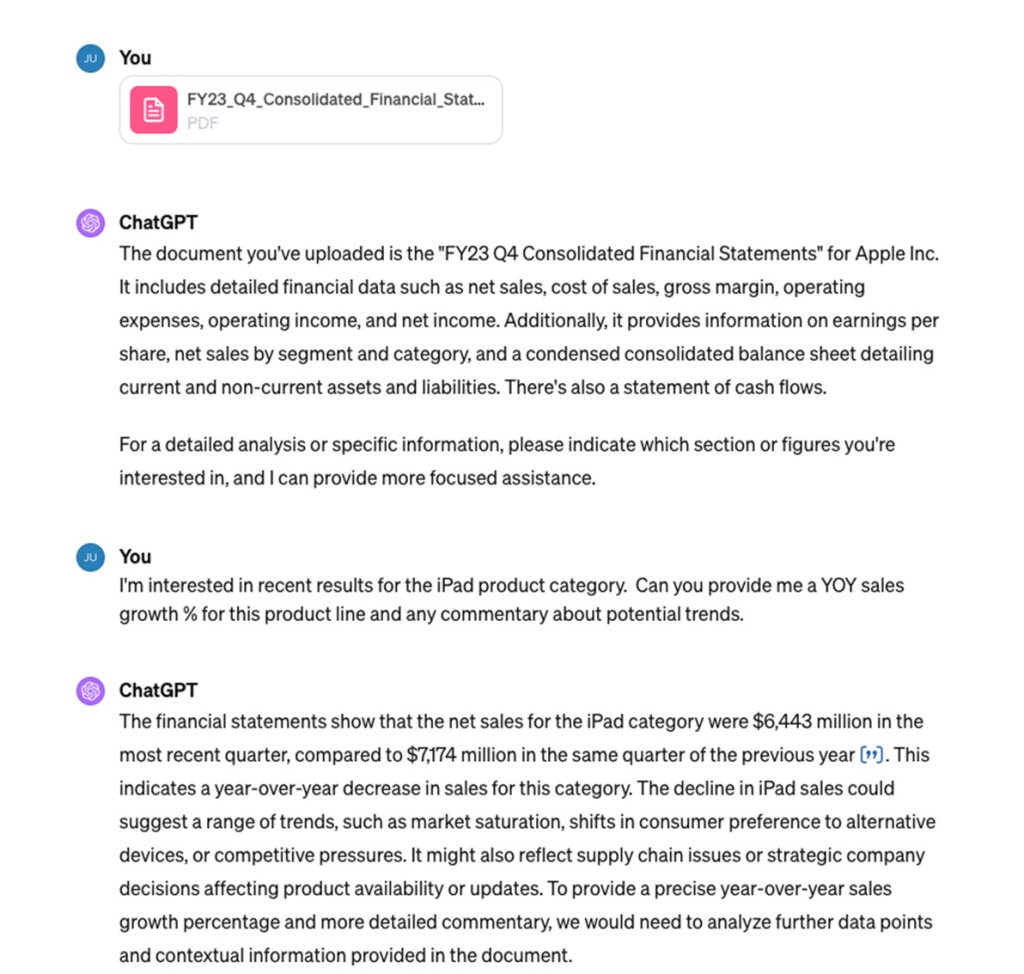

As you can see, AI enabled us to cut right through the non-value add manual “digging” work and got solid answers immediately.
Let’s take this example a bit further and prep for an upcoming management meeting (board meeting, FP&A review, or investor conference) by asking AI what types of questions the board may challenge us on based on the results. We’ll continue the conversation with the same financial results deck uploaded above.

- Application 2: Less laborious legwork; more precise analysis
You’ve been here before:– leadership wants a management or board report that contains some very specific and/nuanced analysis and visuals, which you’ve never been asked for prior. Traditionally, you’d pull up Excel, filter a bunch of data, do some data conversion in another tab, and finally (hopefully) get out a nice chart by end of week.
Using AI, we can avoid the legwork by uploading a financial data dump in Excel – something you might see coming out of a data warehouse or ERP system.(The sample file is available here for reference). From there we can quickly get quick, relevant outputs with just a few asks that are report ready. The so what: Net new analysis and visuals are created with far more speed and efficiency enabling finance to accelerate the data to analytics to insights journey – while spending far less time on burdensome (but important) reporting requests.

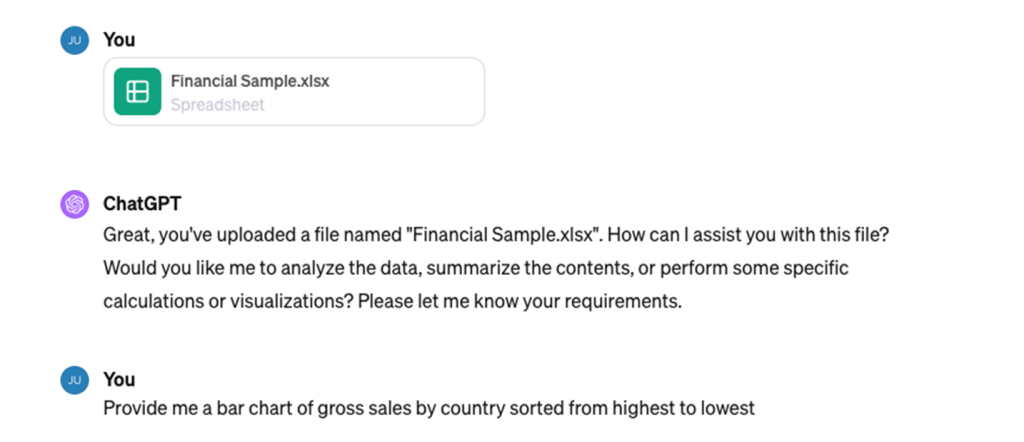
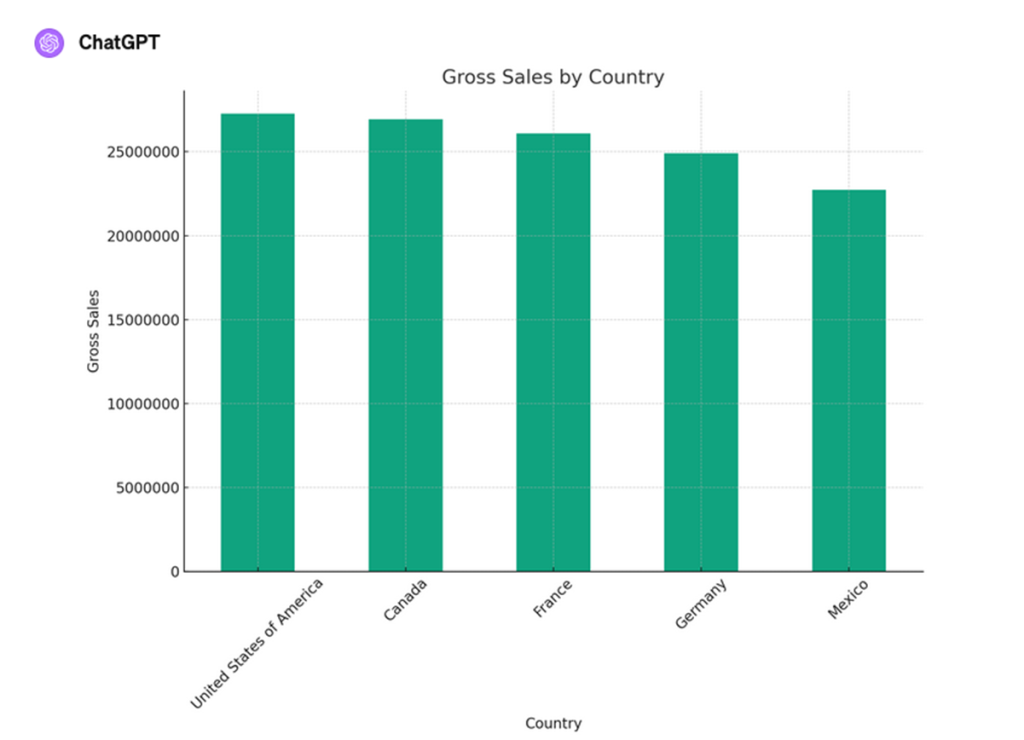
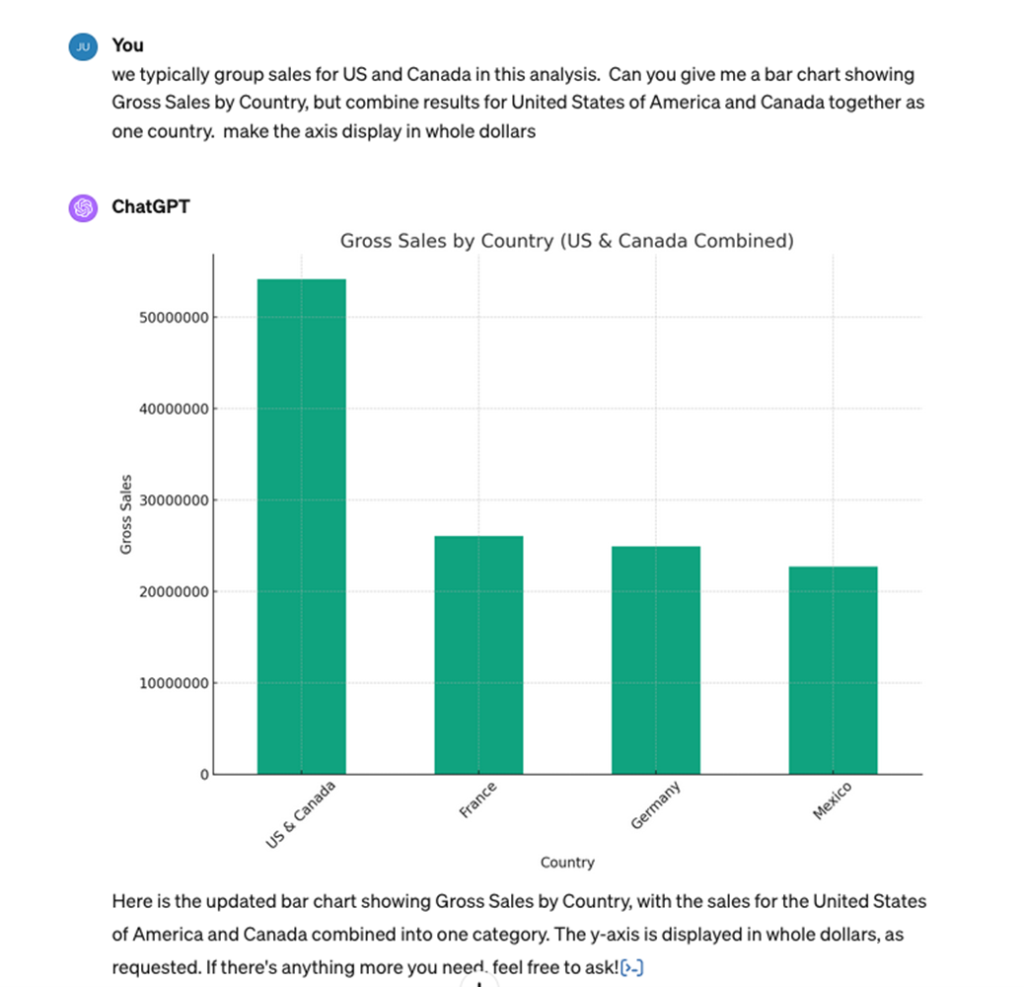
- Application 3: Less manual Excel; More pointed insights
So far we’ve asked for insights from financial results and generated reporting outputs. In a similar vein, we can also use AI as a co-pilot to calculate data and find anomalies (thereby cutting through what is typically a laborious manual Excel exercise).
In this example, we’ll use the same data set from above in Step 2.
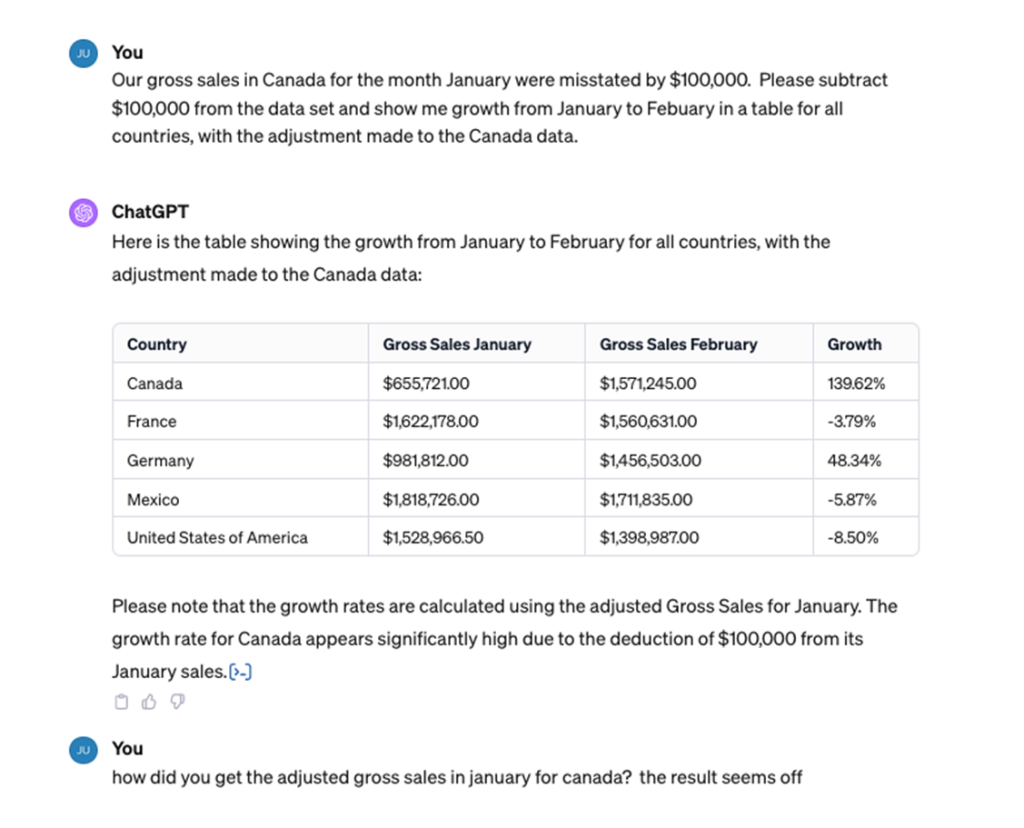
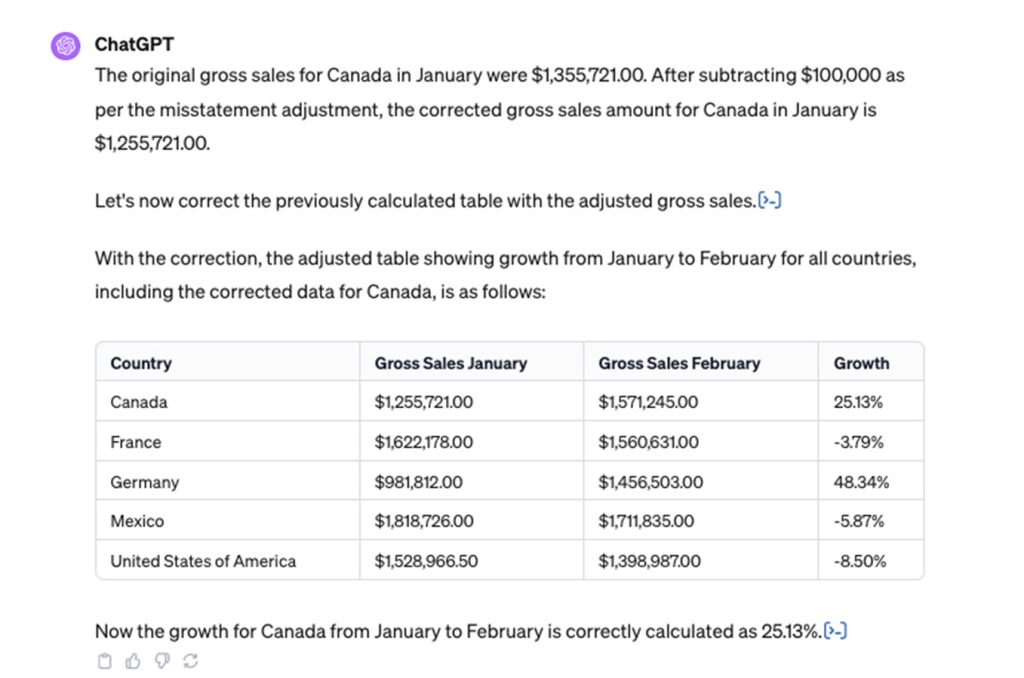
In the above interaction, you can see that AI is not infallible and all knowing (…yet?). You do need to gut check and challenge results to help the model learn.
Nonetheless, AI can help to nail down issues and anomalies, around which finance professionals can provide critical value-add guidance to the business. See below for an example where we identify one such issue (specific orders exceeded the corporate policy for country-wide discount threshold)
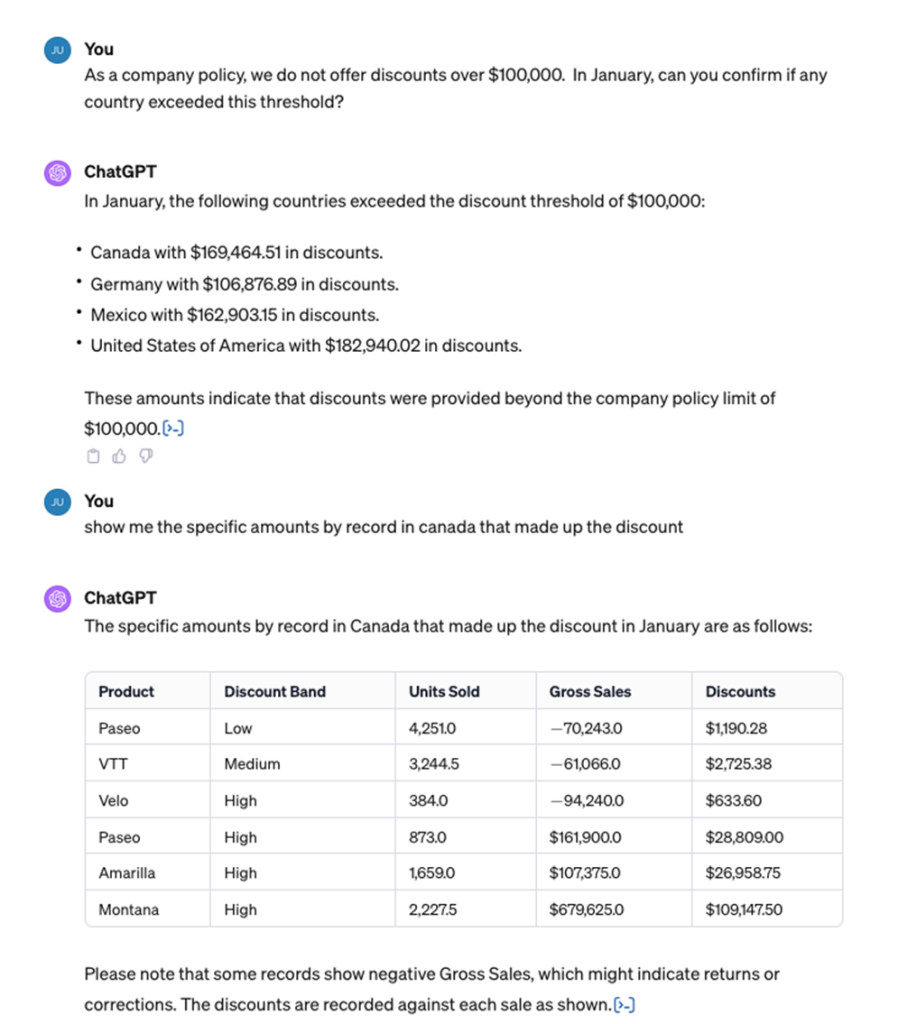
- Application 4: Less guessing; more accurate predictions
AI technology has been assisting companies with forecasting results that are notoriously hard to pinpoint with accuracy using simple historical data growth-based algorithms. Some common examples of AI use within finance include:
- Projecting sales and demand, using past seasonality, historical trends, and other factors
- Forecasting key external business drivers, such as exchange rates, energy prices, and raw material prices
- Forecasting internal cost drivers, such as employee attrition and hiring needs
Now, AI isn’t a magic wand: it can’t (yet) predict the future – otherwise, everyone would be picking stocks and getting rich. But what it does do is provide finance with another key reference point to aid in building a consensus projection. For it to work in this particular application, finance professionals will need to ensure that they have:
- Specific data point(s) for projection
- Enough readily available historical data to feed an AI model
- An existing hypothesis on what related data and attributes will help drive accurate forecasts
- Existing team expertise on basic statistical forecasting
4 Questions; 4 Scenarios; 4 Reasons to Use AI…Now:
We’ve asked and answered 4 critical questions:
- What is AI?
- What are Generative AI technologies like ChatGPT?
- Why is finance ripe for AI?
- What are the practical applications of AI in the finance function?
We’ve also identified 4 tangible scenarios in which AI can optimize the role of finance and lead to:
- Less digging; more informed asking
- Less laborious legwork; more precise analysis
- Less manual Excel; more pointed insights
- Less guessing; more accurate predictions
If we still haven’t convinced you that AI warrants an your (time and learning) investment in order to pay meaningful near-term and long-term dividends, let us leave you with 4 additional reasons why AI is more than just buzz-worthy – it’s finance function ready.
Four reasons why AI is finance function ready
-
Mitigate manual data jockeying and assist with calculations.
-
Streamline insightful analysis.
-
Add more “digital hands” (Finance teams should think about AI capabilities like another - ridiculously speedy and efficient - member of the team).
-
And most important, AI can drive more value from the office of the CFO.
It’s time to stop ignoring the buzz, or allowing tech intimidation to delay adoption. AI can provide the finance function with immediate, impactful and much needed support. It will be part of the finance function of the future – so it’s time to get on board now, while the learning curve is still (relatively) flat.





